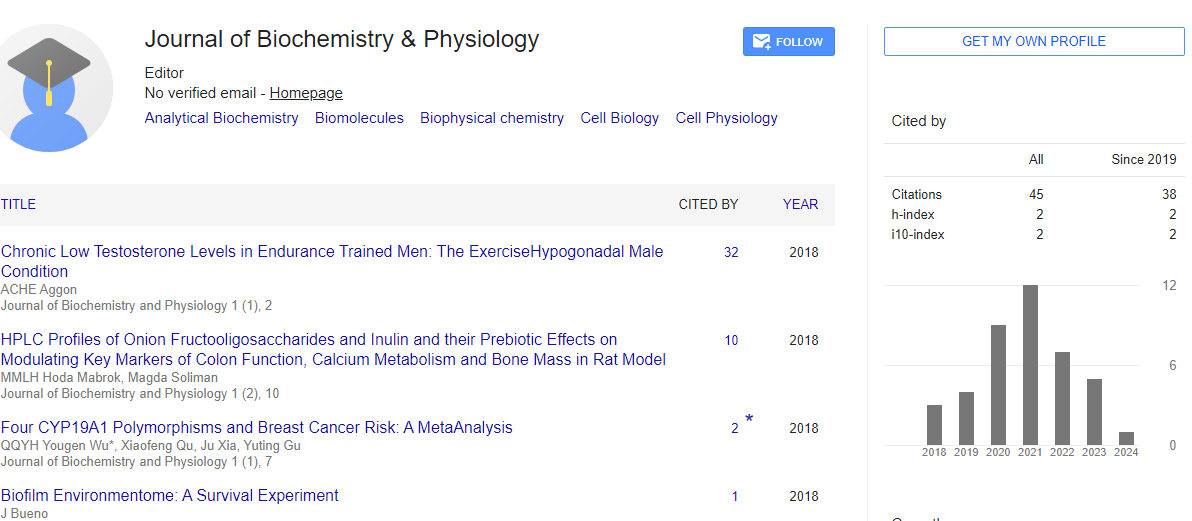About the Journal
Journal of Biochemistry and Physiology (JBPY) is an online open access, peer-reviewed journal committed to publish the latest scientific research and specialized articles in the field of biological chemistry and various aspects of human physiology, pathophysiology, and related fields.
The Journal assimilates the scientific contribution and provides a platform to explore the knowledge in the fields of Biochemical research and Human Physiology. The scope of the Journal emphasizes on the following topics that include: biology of cells, chemical elements, biomolecules, physical properties, chemical processes involved in living organisms, enzymes, metabolism, biochemical techniques, genetics, molecular biology, developmental biology, etc. Journal of Biochemistry and Physiology emphasis on the topics include:
- Analytical Biochemistry
- Biomolecules
- Biophysical chemistry
- Cell Biology
- Cell Physiology
- Clinical Biochemistry
- Enzymology
- Genetics and Genetic Engineering
- Human Physiology
- Microbial Biochemistry
- Molecular Biology
- Nutritional Biochemistry
- Medical Physiology
- Molecular Physiology
- Structural Biology
Journal of Biochemistry and Physiology furnishes an expeditious editorial procedure and a rigorous peer-review system. For qualitative analyses and peer review process, authors can submit the articles which are evaluated by Editors and a group of peer review experts in the field as a result of which the data is specific, authentic and advantageous to the scientific institution.
Analytical Biochemistry
Analytical Biochemistry explains about the study of biochemical components such as proteins, nucleic acid and metabolites, found in a cell or other biological sample. This scientific phenomenon uses a broad range of techniques for separation, identification, quantification and functional characterization of biological molecules. The greatest finding came into existence that the P450 2D6 (CYP2D6) enzyme can metabolize at least 20% of all clinically relevant drugs.
Biomolecules
A Biomolecules are molecule, present in a living organism and are responsible for maintenance and metabolic processes of an organism. Biomolecules can be classified into large macromolecules and small molecules. Carbohydrates, proteins, lipids and nucleic acids are large macromolecules and primary metabolites, secondary metabolites, and natural products are small molecules.It has been recently found that Enzyme-linked immunosorbant assays (ELISA) can be used in multiple stages of the drug discovery process to help identify and measure the cellular responses to therapeutic or toxic molecules.
Biophysical Chemistry
Biophysical chemistry explains about the study of biological systems through the concept of Physics and Physical Chemistry. It provides the information about the physical properties of biological macromolecules at chemical sequence level or a global structural level. The new finding came into existence that the entering of asymmetric dynamics of DNA can strongly excite the confining nanospore.
Cell Biology
Cell Biology explains about study of cell structure, function and the biological processes that takes place in a living organism. The processes which occur in a living cell include cell division, organelle inheritance and biogenesis, signal transduction and motility and are also affected by stimuli from the environment such as nutrients, growth signals, and cell-cell contact. It has been recently found that the Nanoparticles coated with mRNA gives resistant properties against disease to Cells.
Cell Physiology
Cell Physiology explains about the biological study related to cellular activities due to which the cell remains alive. The word Physiology signifies to all normal functions which takes place in a living organism. It has been recently found that Acid-sensing receptor can have beneficial connection to physiological response in panic disorder.
Clinical Biochemistry
Clinical Biochemistry explains about the field of clinical pathology which commonly deals with the analysis of body fluids such as blood, urine, sputum, stool etc., for diagnosis and therapeutic purposes. The analysis of body fluids can be done using the tools of chemistry, microbiology, hematology and molecular pathology. The new finding came into existence that a multimetallic protein, acts like an enzyme and have the capacity to catalyze the action of large number of antibodies.
Enzymology
Enzymology is the branch of medical science which deals with the study of Enzymes, their habit, growth, functioning and also their relation with the environment around them. Enzymes are bioorganic catalysts which have the property of catalyzing the biochemical reaction rapidly. The greatest finding came into existence that mechanism behind the catalysis of DNA polymerase in DNA repair and replication has been successfully identified.
Genetics and Genetic Engineering
Genetic Engineering explains about the manipulation of DNA to make changes in the phenotypic characteristics of an organism. In this process a particular gene of interest (DNA) is inserted into the plasmid of bacteria or yeast cell and allows it to replicate to produce multiple copies of DNA. The greatest finding came into existence that crops that are being consumed by an insect can be protected by using recent technology called “RNA interference” (block protein translation).
Human Physiology
Human Physiology explains about the science of mechanism behind the body works and has become a fundamental discipline of modern medicine. It analyzes the interaction of molecules, cells, tissues and organs, and emphasizes the concept of making up the whole body. The new finding came into existence that autophagy (eating own cell) is an essential component in a neuroendocrine pathway which allows sensory neurons and nutrient levels to work together to influence lifespan. It also reduces the insulin growth factor signaling pathway, by which the cells communicate with their physiologic environment.
Microbial Biochemistry
Microbial Biochemistry is the branch of medical Science which explains about the chemical processes that takes place in microorganisms like bacteria, virus, fungi and some algae. It deals with structures, functions and interactions of biological macromolecules, like carbohydrates, proteins, lipids and nucleic acids within the microorganism. It has been recently found that the methane oxidizing bacteria are capable of reducing greenhouse gas by consuming hydrogen gas to enhance their growth and survival.
Molecular Biology
Molecular Biology is the branch of biology which deals with the study of interactions of macromolecules like DNA, RNA and Proteins and mechanism of their biosynthesis as well as the regulation of these interactions. It explains about the process behind the synthesis of biological macromolecule which is essential for life of an organism like replication, transcription, and translation. The greatest finding came into existence that the mRNA coated with nanoparticles can give the disease encountering properties to cell.
Nutritional Biochemistry
Nutritional Biochemistry is the branch of biological chemistry which is concerned with the applied aspects of physiology, food chemistry, toxicology, pediatrics, and health of an organism. It explains about the study of all vital chemical compounds which is required for growth and development of an organism and the mechanism behind eliminating the disease and improving the health. It has been recently found that consuming protein rich diet, three times a day can lead to greater mass and muscle strength in the elderly.
Medical Physiology
Medical Physiology is the field of medical science which deals with the study of mechanical, physical and biochemical systems of an organism from a molecular level. However, the term medical physiology applies to human beings. It explains the function of different organ system and stimulates the knowledge related to the physiology of an organism at cellular or molecular, behavioral and system level. The new finding broke out into existence that consuming unsaturated fat in high amount and saturated fat in low amount can result in decrease in cholesterol by 10â„… in healthy obese adults.
Molecular Physiology
The term Molecular Physiology explains about the scientific study of various biological processes, their interactions and cell signaling at subcellular level. Cell signaling can be of three types such as surface membrane to surface membrane, exterior, which is between receptors on the cell, and direct communication, which means signals pass inside the cell itself. The new finding came into existence that Presence of etosis in human blood monocytes can lead to trap and kill the pathogens.
Structural Biology
Structural biology is a branch of molecular biology, biochemistry, and biophysics which deals with the structure of biological macromolecules such as proteins and nucleic acids at molecular level and the mechanism behind their formation of structure. It also explains about that how the changes in the molecular structure of biological macromolecule can affect their function. It has been recently found that the endocytic sorting motif interactions are involved in Nef-mediated down modulation of mainly CD4 and CD3 receptors.
Fast Editorial Execution and Review Process (FEE-Review Process):
Journal of Biochemistry and Physiology is participating in the Fast Editorial Execution and Review Process (FEE-Review Process) with an additional prepayment of $99 apart from the regular article processing fee. Fast Editorial Execution and Review Process is a special service for the article that enables it to get a faster response in the pre-review stage from the handling editor as well as a review from the reviewer. An author can get a faster response of pre-review maximum in 3 days since submission, and a review process by the reviewer maximum in 5 days, followed by revision/publication in 2 days. If the article gets notified for revision by the handling editor, then it will take another 5 days for external review by the previous reviewer or alternative reviewer.
Acceptance of manuscripts is driven entirely by handling editorial team considerations and independent peer-review, ensuring the highest standards are maintained no matter the route to regular peer-reviewed publication or a fast editorial review process. The handling editor and the article contributor are responsible for adhering to scientific standards. The article FEE-Review process of $99 will not be refunded even if the article is rejected or withdrawn for publication.
The corresponding author or institution/organization is responsible for making the manuscript FEE-Review Process payment. The additional FEE-Review Process payment covers the fast review processing and quick editorial decisions, and regular article publication covers the preparation in various formats for online publication, securing full-text inclusion in a number of permanent archives like HTML, XML, and PDF, and feeding to different indexing agencies.
 Spanish
Spanish  Chinese
Chinese  Russian
Russian  German
German  French
French  Japanese
Japanese  Portuguese
Portuguese  Hindi
Hindi 
